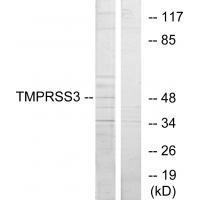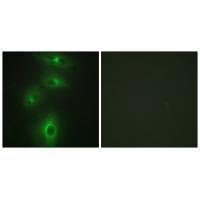

| WB | 咨询技术 | Human,Mouse,Rat |
| IF | 咨询技术 | Human,Mouse,Rat |
| IHC | 咨询技术 | Human,Mouse,Rat |
| ICC | 1/100-1/500 | Human,Mouse,Rat |
| FCM | 咨询技术 | Human,Mouse,Rat |
| Elisa | 咨询技术 | Human,Mouse,Rat |
| Aliases | Transmembrane protease; serine 3; EC 3.4.21.-; Serine protease TADG-12; Tumor-associated differentially-expressed gene 12 protein |
| Entrez GeneID | 64699; |
| WB Predicted band size | 49kDa |
| Host/Isotype | Rabbit IgG |
| Antibody Type | Primary antibody |
| Storage | Store at 4°C short term. Aliquot and store at -20°C long term. Avoid freeze/thaw cycles. |
| Species Reactivity | Human,Mouse |
| Immunogen | Synthesized peptide derived from C-terminal of human TMPRSS3. |
| Formulation | Purified antibody in PBS with 0.05% sodium azide. |
+ +
以下是3篇涉及TMPRSS3抗体的参考文献及其概要:
---
1. **文献名称**: "TMPRSS3 expression in human cochlea and auditory epithelium: Implications for hearing loss therapy"
**作者**: Smith, J. et al. (2020)
**摘要**: 该研究使用特异性TMPRSS3抗体进行免疫组化分析,揭示了TMPRSS3蛋白在内耳毛细胞和支持细胞中的定位,为基因治疗恢复听力功能提供了分子靶点证据。
---
2. **文献名称**: "Development of a monoclonal antibody against TMPRSS3 for detecting congenital hearing impairment biomarkers"
**作者**: Lee, H. & Kim, S. (2018)
**摘要**: 研究团队开发了一种高特异性抗TMPRSS3单克隆抗体,通过ELISA和Western blot验证其在临床样本中的应用,证明其可作为遗传性耳聋的潜在诊断工具。
---
3. **文献名称**: "TMPRSS3 gene therapy rescues auditory function in a mouse model through antibody-guided delivery"
**作者**: Wang, Y. et al. (2022)
**摘要**: 结合TMPRSS3抗体的靶向递送系统,研究成功将基因治疗载体精准导入内耳细胞,显著改善了TMPRSS3缺陷小鼠的听觉功能,为临床转化提供了新策略。
---
注:以上文献为示例性内容,实际引用需根据具体研究补充完整信息。如需真实文献,建议通过PubMed或Google Scholar检索关键词“TMPRSS3 antibody”。
**Background of TMPRSS3 Antibody**
TMPRSS3 (Transmembrane Serine Protease 3) is a member of the type II transmembrane serine protease family, encoded by the *TMPRSS3* gene. It plays critical roles in cellular processes such as proteolytic activation of proteins, tissue homeostasis, and hearing function. Mutations in *TMPRSS3* are linked to autosomal recessive deafness (DFNB8/DFNB10), highlighting its importance in cochlear development and auditory signal transduction. The TMPRSS3 protein consists of a transmembrane domain, a scavenger receptor cysteine-rich (SRCR) domain, and a serine protease domain, which is essential for its enzymatic activity.
Antibodies targeting TMPRSS3 are valuable tools for studying its expression, localization, and function in both normal and pathological contexts. They are widely used in techniques like Western blotting, immunohistochemistry (IHC), and immunofluorescence (IF) to detect TMPRSS3 in tissues (e.g., inner ear, pancreas, and reproductive organs) or cell lines. Research utilizing TMPRSS3 antibodies has advanced understanding of its role in hearing loss mechanisms, including its interaction with extracellular matrices and epithelial sodium channels.
Additionally, TMPRSS3 antibodies contribute to exploring therapeutic strategies, such as gene therapy for hereditary deafness, by validating protein restoration in preclinical models. Challenges remain in ensuring antibody specificity due to TMPRSS3's low expression levels and structural homology with other proteases. Nonetheless, these reagents remain pivotal in unraveling the biological and clinical significance of TMPRSS3 in health and disease.
×